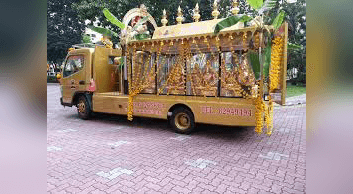Hearse Van

India, our country, is in an uproar over instances of people being forced to carry their deceased relatives for miles. Some state governments are asking their state medical and health department for purchasing air-conditioned hearse vans meant for transporting bodies from state-run hospitals to their residences in a perfectly preserved state for free of cost.

The hearse van will transport bodies from government hospitals to the deceased’s residence at all hours of the day. Government hospitals receive patients from faraway. Even an 800-bed Hospital does not have a single hearse van. The attendants have to book vehicles for transporting bodies.
The hearse van facility is primarily meant for the all to transport the body of their deceased. We ensure the availability of transportation for all people. The story of a man carrying his wife’s dead body should never be repeated. We need to assure the dignity of the individual.
Ours is not Last Rites India…but I would prefer to call it as the Life Celebration Center. A hearse van need not be the a big, black, station wagon stating “Dead body on board”. Nor it should be a ‘Vaikunta Vaahanam’. Nor can that be a light silver customized Maruthi minivan. We want this to be a good air-conditioned vehicle where the last ride of the deceased on this earth to take place, while assuring the dignity of the departed soul. In the funeral language of some countries hearses are called funeral coach.
The name is derived, through the French herse, from the Latin herpex, which means a harrow. The funeral hearse was originally a wooden or metal framework, which stood over the bier or coffin and supported the pall. It was provided with numerous spikes to hold burning candles, and, owing to the resemblance of these spikes to the teeth of a harrow, was called a hearse. Later on, the word was applied, not only to the construction above the coffin, but to any receptacle in which the coffin was placed. Thus from about 1650 it came to denote the vehicle on which the dead are carried to the grave.
Hearses were originally hand-drawn then horse-drawn after the decoration and weight of the hearse increased. The first electric motorized hearses were introduced to the United States in the early 1900s. Petrol-powered hearses began to be produced from 1907 and, after slow initial uptake due to their high cost, became widely accepted in the 1920s. The vast majority of hearses since then have been based on larger, more powerful car chassis, generally retaining the front end up to and possibly including the front doors but with custom bodywork to the rear to contain the coffin.
A hearse vehicle is used to pick up the remains of a recently deceased person, and transport that person to the funeral home for preparation.
A few big cities across the world provide special rail funeral trolley cars to carry bodies and mourners to remote cemeteries.
The motorcycle hearse has become popular and is often used during the funeral of motorcycle enthusiasts. This type of hearse is either a motorcycle with a special sidecar built to carry a casket or an urn at the side of the rider, or it is a trike that carries the casket behind the rider.



Two styles of formal hearse vans are common. One style has opaque rear panels so the coffin is barely glimpsed. The other has narrow pillars and large windows revealing the coffin.
